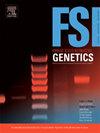外周血中tsRNA表达谱的差异可有效区分同卵双胞胎
IF 3.1
2区 医学
Q2 GENETICS & HEREDITY
引用次数: 0
摘要
单卵双胞胎(MZTs)具有几乎相同的基因组DNA序列,使得传统的法医短串联重复序列(STR)基因分型方法无法区分它们。近年来,表观遗传因素在法医应用中的应用已经获得了牵引力。动态表观遗传因子可受遗传性状或后天环境因素的影响。本研究采用全景RNA显示技术,通过克服RNA修饰流产测序(PANDORA-seq)分析了4对成年MZTs外周血中转移RNA来源的小RNA (tsRNAs)的表达谱。利用逆转录酶定量聚合酶链式反应(RT-qPCR)和液滴数字PCR (ddPCR)在成人和新生儿MZTs中鉴定和验证了差异表达的tsRNAs (DEtsRNAs)。该研究还评估了detsrna对老年血迹的纵向时间稳定性、抗降解性和适用性。通过PANDORA-seq,在4对成年MZTs中共鉴定出8795个表达的tsRNAs。经归一化| log2 (fold change)筛选| >; 1和调整p值<; 后,4对、3对和2对MZTs共有0.05、10、187和1520个detsrna。RT-qPCR和ddPCR证实了PANDORA-seq鉴定的10个DEtsRNAs的表达。6种候选tsrna (tRNA-Gly-GCC、tRNA-Leu-TAA、tRNA-Lys-CTT、trna - var - aac_5_end、tRNA-iMet-CAT_5_end和tsRNA-3023a/b-PheGAA)被鉴定为有效的鉴别标记,即使在新生儿MZTs中也是如此,这些MZTs在很大程度上不受环境因素的影响。法医适用性评估显示,tRNA-Gly-GCC和tRNA-Leu-TAA在180 d系列血迹中仍可检测到,而tRNA-Lys-CTT、tRNA-Val-AAC_5_end和tRNA-iMet-CAT_5_end经过15次冻融循环后相对稳定。此外,tRNA-Gly-GCC和tRNA-Lys-CTT表现出长期稳定性,在6个月内表达一致。综上所述,本研究表明tsRNAs的差异表达可以作为法医学中MZT鉴定的一种新的生物标志物。本文章由计算机程序翻译,如有差异,请以英文原文为准。
Differences of tsRNA expression profiles efficiently discriminate monozygotic twins in peripheral blood
Monozygotic twins (MZTs) share nearly identical genomic DNA sequences, making traditional forensic short tandem repeats (STR) genotyping methods ineffective for distinguishing between them. In recent years, the use of epigenetic factors in forensic applications has gained traction. The dynamic epigenetic factors can be influenced by inherited traits or acquired environmental factors. This study analyzed the expression profiles of transfer RNA-derived small RNAs (tsRNAs) in peripheral blood from four pairs of adult MZTs using Panoramic RNA Display by Overcoming RNA Modification Aborted Sequencing (PANDORA-seq). Differentially expressed tsRNAs (DEtsRNAs) were identified and validated using the reverse-transcriptase quantitative polymerase chain reaction (RT-qPCR) and droplet digital PCR (ddPCR) in both adult and newborn MZTs. The study also evaluated the longitudinal temporal stability, resistance to degradation, and suitability of DEtsRNAs for aged bloodstains. A total of 8795 expressed tsRNAs were identified in the four pairs of adult MZTs by PANDORA-seq. After screening with a normalized | log2 (fold change) | > 1 and an adjusted p-value < 0.05, 10, 187, and 1520 DEtsRNAs were shared by 4, 3, and 2 pairs of MZTs. RT-qPCR and ddPCR confirmed the expression of the 10 DEtsRNAs identified by PANDORA-seq. Six candidate tsRNAs (tRNA-Gly-GCC, tRNA-Leu-TAA, tRNA-Lys-CTT, tRNA-Val-AAC_5_end, tRNA-iMet-CAT_5_end, and tsRNA-3023a/b-PheGAA) were identified as effective discrimination markers, even in neonatal MZTs which are largely unaffected by environment factors. Forensic applicability assessment revealed that tRNA-Gly-GCC and tRNA-Leu-TAA remained detectable in the 180-day-series bloodstains, while tRNA-Lys-CTT, tRNA-Val-AAC_5_end, and tRNA-iMet-CAT_5_end were relatively stable after 15 times of freeze-thaw cycles. Additionally, tRNA-Gly-GCC and tRNA-Lys-CTT exhibited long-term stability, with consistent expression over six months. In conclusion, this study demonstrates that differential tsRNAs expression can serve as a novel biomarker for MZT identification in forensic medicine.
求助全文
通过发布文献求助,成功后即可免费获取论文全文。
去求助
来源期刊
CiteScore
7.50
自引率
32.30%
发文量
132
审稿时长
11.3 weeks
期刊介绍:
Forensic Science International: Genetics is the premier journal in the field of Forensic Genetics. This branch of Forensic Science can be defined as the application of genetics to human and non-human material (in the sense of a science with the purpose of studying inherited characteristics for the analysis of inter- and intra-specific variations in populations) for the resolution of legal conflicts.
The scope of the journal includes:
Forensic applications of human polymorphism.
Testing of paternity and other family relationships, immigration cases, typing of biological stains and tissues from criminal casework, identification of human remains by DNA testing methodologies.
Description of human polymorphisms of forensic interest, with special interest in DNA polymorphisms.
Autosomal DNA polymorphisms, mini- and microsatellites (or short tandem repeats, STRs), single nucleotide polymorphisms (SNPs), X and Y chromosome polymorphisms, mtDNA polymorphisms, and any other type of DNA variation with potential forensic applications.
Non-human DNA polymorphisms for crime scene investigation.
Population genetics of human polymorphisms of forensic interest.
Population data, especially from DNA polymorphisms of interest for the solution of forensic problems.
DNA typing methodologies and strategies.
Biostatistical methods in forensic genetics.
Evaluation of DNA evidence in forensic problems (such as paternity or immigration cases, criminal casework, identification), classical and new statistical approaches.
Standards in forensic genetics.
Recommendations of regulatory bodies concerning methods, markers, interpretation or strategies or proposals for procedural or technical standards.
Quality control.
Quality control and quality assurance strategies, proficiency testing for DNA typing methodologies.
Criminal DNA databases.
Technical, legal and statistical issues.
General ethical and legal issues related to forensic genetics.

 求助内容:
求助内容: 应助结果提醒方式:
应助结果提醒方式:


